39 Easy Yet Impressive Painting Techniques
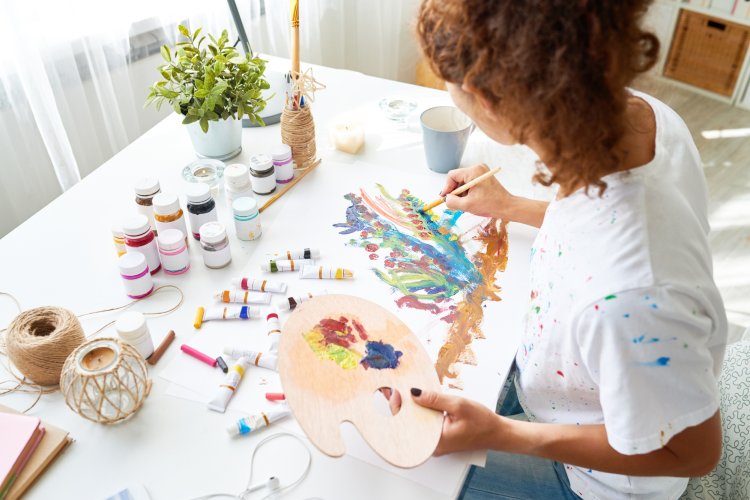
Have you been wanting to try some new painting techniques, but maybe thought they would be too challenging?
In a Brown University study of the renowned painter — and creator of one of the most expensive paintings ever sold — Jackson Pollock paintings and his "drip technique," Professor Roberto Zenit states that "Like most painters, Jackson Pollock went through a long process of experimentation in order to perfect his technique."
So, take your time and experiment. If the Neanderthals could create epic cave paintings, so can you. You've got this! To get you started, here is a list of techniques that can improve your painting and help you discover new talents. Give some of these a try the next time you are relaxing with your easel.
Jump to Section
- How to Master New Painting Techniques
- Acrylic Painting Techniques
- Oil Painting Techniques
- Textured Painting Techniques
- Paint Pouring Techniques
- Abstract Painting Techniques
How to Master New Painting Techniques
The best way to master new painting techniques is through painting classes. From watercolors to oils, or abstract to realistic focus, you can explore the painting techniques that have always sparked your interest.
To learn from home, join online painting classes led by experienced artists who will walk you through each of these creative painting ideas, and you will finish the interactive class with lots of painting tips and a beautiful painting you can be proud of.
Some people enjoy taking classes from their homes, while others prefer in-person classes. If you really want to let your creativity flow, try fun paint and sip in Sacramento, paint and sip in San Diego, paint and sip in Boston, or paint and sip near you.

Acrylic Painting Techniques
1. Splattering
To create splatters on a painting, dip the brush in water before dipping into the paint, then flick the color onto the surface.

2. Blocking In
One acrylic painting technique is to start with a broader brush to block or fill in larger segments of the design, and then move to progressively finer widths and dimensions as you build up layers of paint. Use the smallest, finest brushes last for surface details.
3. Dry Brushing
Dry brushing is a technique often used when painting rocks and grass. To dry brush, put a little bit of paint on a brush and make quick, light movements over the dry paint that is already there.
4. Sgraffito
Sgraffito is a technique involving scratching a surface to remove paint to reveal a layer underneath. You can use anything that has a point to do this: a palette knife, the end of a brush or even your fingernail.
5. Stippling
The stippling technique uses a fine point brush to create tiny dots on the surface of a painting. You can also use a ballpoint pen, sharp pencil or fine-point marker.
6. Underpainting
Artists don’t paint directly on a white canvas with acrylics or oils. Instead, they use a technique called underpainting. Starting with a dark color like burnt umber, burnt sienna or phthalo blue, layers of paint are added on top of the bottom layer to create shadows.
7. Dabbing
This technique is useful for creating foliage on trees and bushes. Dabbing involves repeatedly tapping the canvas to spread the paint and create a texture. You can use many things for this technique: brushes, a palette knife, paper towels and crumpled foil or plastic bags.
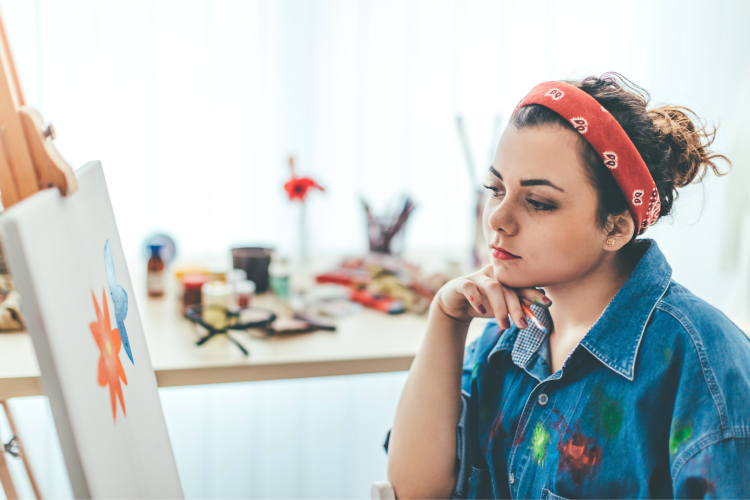
8. Glazing
Glazing refers to applying a coat of transparent paint over a section of the canvas where the paint is dry. This technique can be used to make shadows stand out or to change the color of some parts of the painting.
9. Washing
The technique of washing involves adding water to acrylic paint to give a watercolor effect.
Oil Painting Techniques
10. Chiaroscuro
This is an oil painting technique that uses an area of light against a darker background. Chiaroscuro was popular with Renaissance and Baroque artists and seen in many famous Renaissance paintings and Caravaggio paintings.
11. Scumbling
Scumbling is similar to dry brushing, but it leaves a texture on the canvas. Try this as a fun, unique technique when you learn how to start oil painting.
12. Alla Prima
Most painting techniques involve applying layers over dry paint. Alla Prima, also called wet-on-wet painting, allows painters to work more quickly, but it is not a beginner’s technique. Van Gogh and Monet favored Alla Prima painting.
Textured Painting Techniques
13. Fingerpainting
Yep, fingerpainting is a real painting technique. You can use the tips of your fingers to blend colors or create textures. Keep a damp rag or paper towels nearby to wipe your hands before touching anything.
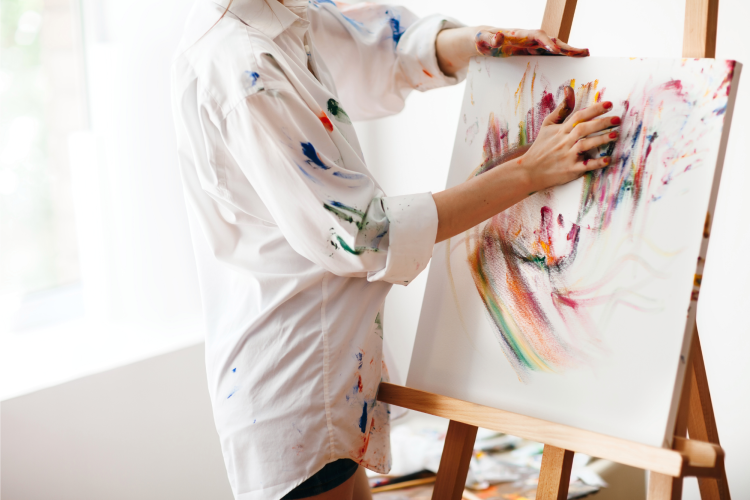
14. Blunt End of a Brush
Using the blunt or tapered end of a paintbrush in wet paint is a useful technique for removing paint that leaves stark lines. This painting technique is often used for creating tree trunks and branches and to highlight the edges of objects.
15. Paper Towel
A piece of paper towel can be used for blending colors or removing paint from a section of the canvas. The paper towel painting technique can achieve a similar effect to wide brushes.
16. Tip of Knife or Fingernail
This technique is similar to the end of the brush, although the lines can be finer.
17. Palette Knife
A palette knife can be used to spread thick layers of color or to create a strong texture by tapping the knife on the wet paint.
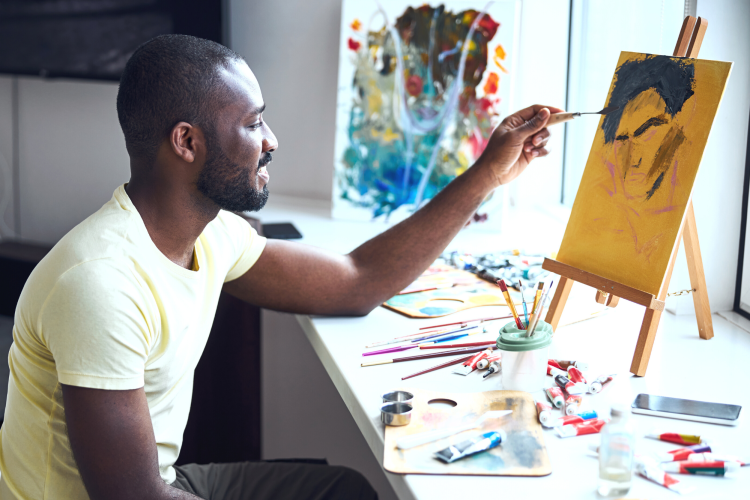
18. Plastic Bag
If you ball up a plastic bag, you can use it to apply paint in a wide stroke or to create texture by tapping areas of the canvas with the ball.
19. Crumpled Foil
Pieces of crumpled aluminum foil can create textures similar to the plastic bag, but the stiffness of the foil leaves a slightly different finish.
20. Cotton Buds
Cotton buds are inexpensive and useful for painting, especially to add texture. They can be used to create a sense of movement in clouds or water, and can also be used with a solvent to remove areas of color to create a texture.
Paint Pouring Techniques
21. Clean Pour
Acrylic paint pouring techniques can be used to create some simple paintings that are beautiful and interesting. The technique called clean pour is the simplest, and only involves pouring one color at a time.
22. Dirty Pour
The dirty pour painting technique involves layering two or more colors in cup before pouring. Most pouring techniques fall into the dirty pour category.
23. Faux Marble
This is a dirty pour technique where the paint is poured onto the surface, which is then manipulated or tilted to shift the paint around. This painting technique produces a design that looks very much like marble.

24. Flip Cup
Flip cup is a technique where a cup of paint is turned over on a surface and then pulled off to let the paint flow. You can also poke holes in the top of the cup and let the change in pressure push the paint out from under the cup.
25. Balloon Smash
In the balloon smash painting technique, a background color is applied to the canvas, which is tilted until the entire surface is covered. Then small pools of color are poured on the canvas, and then the pools are smacked with an inflated balloon. Hard smacks produce splashes of color, while gentle ones create more circular designs.
26. Swipe
The swiping technique is more advanced. It involves pouring the paint on the surface and gently swiping a palette knife or a spatula across the paint. The trick with swiping is not to press too hard or the colors will mix too much and become muddy.
27. Torching
Torching creates an intriguing design. Using a small torch, like you would use to brown the top of crème brûlée, paint can be “torched” to darken it and create bubbles on the surface.
28. Tree Ring
In the tree ring pour painting technique, a small spout is made in the top of the cup by pinching the rim. Pour the paint onto the surface in a very tight circle, then lift it and manipulate the surface to produce an effect that looks like growth rings in a cross-section of a tree.
29. Puddle Pour
In a puddle pour, a dirty cup of paint is poured onto different sections of the canvas, which is then manipulated to move the paint and create a design. You can also blow on it with a dryer set on low for a fascinating wave design.
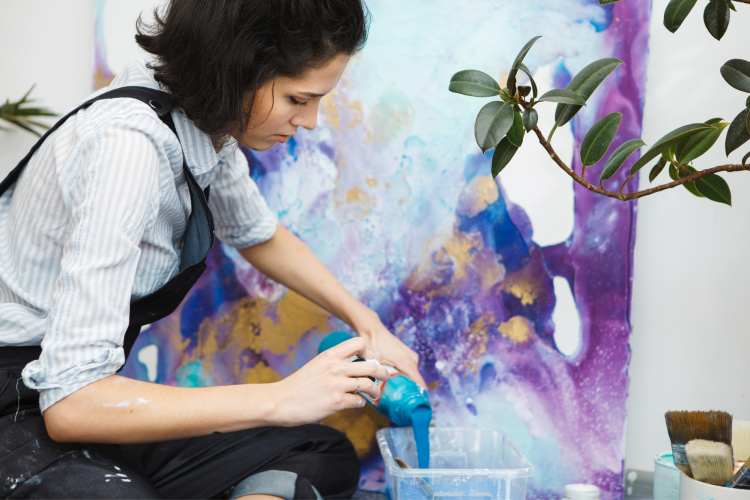
30. String Pull
In a string pull, small blobs of color are poured in a row and a string is placed in the paint. You can use the string painting technique to create feathers, or flowers or abstract designs.
31. Resin Pouring
The resin pour technique uses two-part epoxy and paint to create effects. Mix the epoxy in the cup first and then add the paint. The trick to this pour is timing. Epoxy sets quickly, so you have to do any manipulations before this happens. Epoxy has a tendency to bubble, so use a straw or a torch to pop them before the resin sets.
32. Dutch Pouring
The Dutch pour starts out like the others with a background color and pools of other colors around the surface. Then take a straw or a blow dryer and gently blow the colors to create designs.
33. Dip Pouring
A dip uses two canvases. The paint is applied to one and the second is pressed carefully on top of the first. You can manipulate one or both canvases or leave them as they are.
Abstract Painting Techniques
34. Flip the Canvas
This abstract technique involves starting a painting and then turning the canvas upside down or on its side. Keep painting and see what comes out. You can flip the canvas as many times as you want.
35. Paint to Music
Listening to music can raise your spirits and it can influence your painting, too. Consider creating a painting playlist to listen to as you work. Try painting in time with the music just to see what comes out.

36. Collage
Collage uses pieces of paper to create a design. You can use newspapers, magazines, photographs, wrapping paper or even pages from an old phone book. Cut or tear the paper into shapes and stick them onto a painting or create an entire design from the pieces of paper. Collage creates a wonderful physical and visual texture and can be used to create simple paintings or complex designs.
37. Photography
Another technique is to use photography as a reference. Take photos of interesting items and paint them in different colors or orientations. Try repeating the objects for a different effect.
38. Let the Brush Take Over
In this technique, you give up control of the brush and let it go where it wants. Don’t try to paint something — just let the brush go and see what comes out. Abstract art is all about experimentation.
39. Forget the Rules
There are really no rules as to how to do things, so let your imagination flow. Have fun with color and texture. Play with different painting techniques and see which ones you enjoy the most.
Don’t be afraid to try these painting ideas. You never know which painting techniques you will fall in love with, or what creative painting ideas will become your favorites.
For even more fun painting tips and ideas, check out other experiences happening on Classpop!

